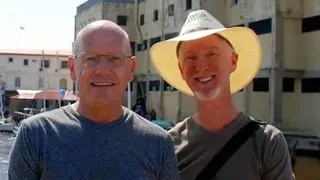December 13, 2013
HIV Back in "Cured" Bone Marrow Transplant Patients
Winnie McCroy READ TIME: 3 MIN.
Two patients who were believed to have been cured of HIV and cancer after bone marrow transplants discovered that their HIV recently returned, one in August and the other in November. The men had been off medications for months after the HIV virus initially disappeared, but are currently back on antiretrovirals and "in good health."
"Both patients have resumed therapy and are currently doing well," said Dr. Timothy J. Henrich in a statement. "I am thankful for their commitment to research and our shared dedication in understanding this virus to benefit all HIV patients."
The two HIV-infected Boston men had suffered from lymphoma and HIV when doctor Henrich of the Brigham and Women's Hospital attempted a marrow transplant. He was attempting to replicate results in the so-called "Berlin patient," Timothy Ray Brown, who has been HIV-free since a 2008 bone-marrow transplant. But Brown's donor had a rare mutation known as CCR5 delta 32, which makes blood cells impervious to HIV.
According to CNN doctors detected HIV in their blood four months after the transplant, but six to nine months later, all traces of the virus were gone. HIV returned in one man 12 weeks after stopping ARVs, and in the other, 32 weeks after stopping therapy. Both men had been on ARVs for years before being diagnosed with lymphoma.
"The return of detectible levels of HIV in our patients is disappointing, but scientifically significant," said Henrich in his statement. "We have demonstrated HIV can be reduced to undetectable levels by very sensitive research assays and the virus persists."
Henrich said that scientists had learned through this research that the HIV reservoir is deeper and more persistent than previously known, and that current standards of probing for HIV may not be sufficient to inform if long-term HIV remission is possible if ARV therapy is stopped. He also said that there may be an important long-lived HIV reservoir outside the blood compartment.
The Boston men's donor marrow did not have this mutation, but Henrich hoped that the blood cells from the new marrow would kill the cancerous and HIV-infected blood cells.
But as Dr. Steven G. Deeks, an AIDS researcher at the University of California, San Francisco, told the New York Times in a recent article, "it just takes one virus in one cell."
Henrich warned of this possibility, saying the virus "could come back in a week or in six months."
Dr. Anthony Fauci, director of the National Institute of Allergy and Infectious Diseases, said that while the failure "doesn't put an end to this avenue of research, it certainly does put a damper on it."
Although there may be a way to make bone marrow transplants work for HIV patients, Fauci said, "it tells you for sure that it's not going to be easy."
According to Bloomberg News, this leaves just two people who have been cured of HIV: Brown, and an infant born with HIV in Mississippi in 2010, who was cured after intensive treatment shortly after birth.
Researchers hope that Henrich will continue his work, pointing to the success in the case of the Mississippi child. amfAR helped fund the study, and says that while stem cell transplantation is not a viable option for all people with HIV, the research could lead to new approaches to testing and eradicating HIV.
"Dr. Henrich is charting new territory in HIV eradication research," Dr. Rowena Johnston, amfAR vice president and director of research, told CNN. "Whatever the outcome, we will have learned more about what it will take to cure HIV. We believe amfAR's continued investments in HIV cure-based research are beginning to show real results and will ultimately lead us to a cure in our lifetime."
Winnie McCroy is the Women on the EDGE Editor, HIV/Health Editor, and Assistant Entertainment Editor for EDGE Media Network, handling all women's news, HIV health stories and theater reviews throughout the U.S. She has contributed to other publications, including The Village Voice, Gay City News, Chelsea Now and The Advocate, and lives in Brooklyn, New York.




